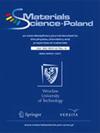18CrNiMo7-6钢渗碳淬火过程应力场模拟及试验验证
IF 1.1
4区 材料科学
Q3 Engineering
引用次数: 1
摘要
通过模拟方法和实验,对18CrNiMo7-6钢的渗碳淬火过程进行了研究。本研究旨在准确预测渗碳试样淬火后的残余应力分布。通过X射线衍射测量应力和残余奥氏体量。类似地,分别使用碳硫分析仪测定碳含量。建立了热场、金属场和机械场耦合的详细模型,以预测淬火过程中应力场的演变。使用不同碳势的渗碳“彻底”试样来获得有限元模拟所需的力学性能参数和膨胀参数。结果表明,18CrNiMo7-6合金钢的马氏体相变动力学参数α值应为0.0202。随着碳含量的增加,转变塑性系数K呈“蜱”形变化。淬火过程后,渗碳层表面产生压缩残余应力场,最大值340MPa出现在表面以下~0.9mm处。有限元模拟预测的碳分布和残余应力场与实验确定的结果非常一致。本文章由计算机程序翻译,如有差异,请以英文原文为准。
Stress Field Simulation and its Experimental Verification of Carburizing-Quenching Process Performed on 18CrNiMo7-6 Steel
The carburizing and quenching process of 18CrNiMo7-6 steel was performed through simulation methods and experiments. The study was carried out to accurately predict the residual stress distribution of carburized samples after the quenching process. The stress and retained-austenite amount were measured via X-ray diffraction. Similarly, the carbon content was determined using a carbon sulfur analyzer, respectively. A detailed model with the coupling of thermal, metallic, and mechanical fields was built to predict the evolution of the stress field during the quenching process. The carburized “thoroughly” specimens at different carbon potentials were used to obtain the required mechanical property parameters and dilatometric parameters for FEM simulation. According to the results, the martensite transformation kinetic parameters α value of 18CrNiMo7-6 alloy steel should be 0.0202. With the increase of carbon content, the changing trend of the transformation plasticity coefficient K appeared as a 'tick' shape. A compressive residual stress field was generated at the carburized layer surface after the quenching process, and the maximum value of 340 MPa occurred at ~ 0.9 mm below the surface. The carbon profile and residual stress fields predicted from the FEM simulation corresponded closely to the experimentally determined results.
求助全文
通过发布文献求助,成功后即可免费获取论文全文。
去求助
来源期刊

Materials Science-Poland
工程技术-材料科学:综合
CiteScore
1.70
自引率
18.20%
发文量
0
审稿时长
6.2 months
期刊介绍:
Material Sciences-Poland is an interdisciplinary journal devoted to experimental research into results on the relationships between structure, processing, properties, technology, and uses of materials. Original research articles and review can be only submitted.
 求助内容:
求助内容: 应助结果提醒方式:
应助结果提醒方式:


